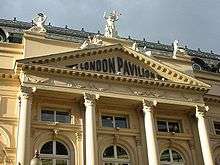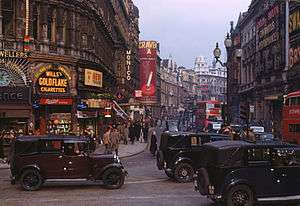London Pavilion
| 1859 London Pavilion Music Hall | |
 Façade of the London Pavilion in 2002 | |
| Address |
Shaftesbury Avenue Westminster, London |
|---|---|
| Coordinates | 51°30′37″N 0°08′02″W / 51.510278°N 0.133889°W |
| Owner | Burford Group |
| Designation | Grade II listed[1] |
| Current use | Trocadero Centre |
| Construction | |
| Opened | 1859 |
| Rebuilt |
1900 & 1918 Wylson & Long 1934 converted to cinema by F Chancellor |
| Years active | 1859–1934 |
| Architect | James Ebenezer Saunders and Robert Worley (1885) |
| Website | |
| www.londontrocadero.com | |
The London Pavilion is a building on the corner of Shaftesbury Avenue and Coventry Street on the north-east side of Piccadilly Circus in London. It is currently a shopping arcade and part of the Trocadero Centre.
Early history
The first building bearing the name, a music hall formed from roofing the yard of the Black Horse Inn, was built in 1859 for Emil Loibl and Charles Sonnhammer. A gallery was constructed for the hall but it could not utilise the full width, because one part of the premises was used by Dr Kahn's "Delectable Museum of Anatomy".[2]

In 1885 Shaftesbury Avenue was built through part of the site, and a new London Pavilion Theatre was constructed. This opened on 30 November 1885 with a popular revue.[4] The new theatre was the first 'music hall deluxe', with marble-topped tables for dining in the auditorium. According to Charles Stuart and A.J. Park in The Variety Stage (1895) the rebuilding signalled a new era of variety theatre:
Hitherto the halls had borne unmistakable evidence of their origins, but the last vestiges of their old connections were now thrown aside, and they emerged in all the splendour of their new-born glory. The highest efforts of the architect, the designer and the decorator were enlisted in their service, and the gaudy and tawdry music hall of the past gave way to the resplendent 'theatre of varieties' of the present day, with its classic exterior of marble and freestone, its lavishly appointed auditorium and its elegant and luxurious foyers and promenades brilliantly illuminated by myriad electric lights
Twentieth century
The success of the venture led its owner, Villiers, to form a limited company; this became the first combine of music halls, Syndicate Halls Ltd. Lupino Lane made his London début here in 1903, as "Nipper Lane".[5]
Between 1912 and 1936 the theatre presented a regular programme of musicals; these included Noël Coward's first success, On With the Dance in April 1925. There were appearances by Sir Harry Lauder; in October 1921 the American actor and vocalist Clifton Webb appeared here in The Fun of the Fair and again in October the following year as Phidas in Phi-Phi. In 1923 electric billboards were erected for the first time on the side of the building.[6]


In 1934 the building underwent significant structural alteration, and was converted into a cinema at a cost of £70,000 by F. G. M. Chancellor, of Frank Matcham and Co.[6] It was the venue for the première of many films including The Curse of Frankenstein in May 1957 for which the foyer was revamped to look like Frankenstein's laboratory, complete with the Monster in a tank.[7] In October 1962 it premiered Dr. No, the first James Bond film, and in July 1964 was the venue for the premiere of A Hard Day's Night. In 1986 the Pavilion closed its doors forever as a theatre. The interior of the building was gutted and converted into a shopping arcade, preserving only the 1885 façade and the outer walls and roof. A wax figure exhibition opened in the building that same year, run by the Madame Tussauds Group, called Rock Circus. The exhibition consisted of waxworks of famous rock and pop musicians. The Rock Circus exhibition closed in September 2001.
Twenty-first century
In 2000 the building became part of the Trocadero Centre, and signage on the building was altered in 2003 to read London Trocadero.
The basement of the building connects with Piccadilly Circus tube station and the rest of the Trocadero Centre.
The London Pavilion now houses Ripley's Believe It or Not!, a visitor attraction dedicated to the weird, the unusual and the unbelievable, which opened in August 2008.
References and sources
- References
- ↑ Historic England. "Details from listed building database (1226674)". National Heritage List for England. Retrieved 29 September 2015.
- ↑ The Old Pavilion (Arthur Lloyd). The site includes a photograph of the premises. Accessed 25 October 2007
- ↑ http://www.museumoflondonprints.com/image/440434/unknown-interior-of-newly-opened-london-pavilion-music-hall-1861
- ↑ The Entr'acte, London, Saturday, 5 December 1885, p.6a (Footlight Notes). accessed 13 October 2007
- ↑ Oxford Dictionary of Biography "Lupino Lane"
- 1 2 Shaftesbury Avenue, Survey of London: volumes 31 and 32: St James Westminster, Part 2 (1963), pp. 68–84 accessed 13 October 2007
- ↑ Sinclair McKay (2007) A Thing of Unspeakable Horror: The History of Hammer Films: 35
- Sources
- Guide to British Theatres 1750–1950, John Earl and Michael Sell pp. 123 (Theatres Trust, 2000) ISBN 0-7136-5688-3
- Who's Who in the Theatre, edited by John Parker, 10th edition revised, London, 1947, p. 1429.
External links
| Wikimedia Commons has media related to London Pavilion. |